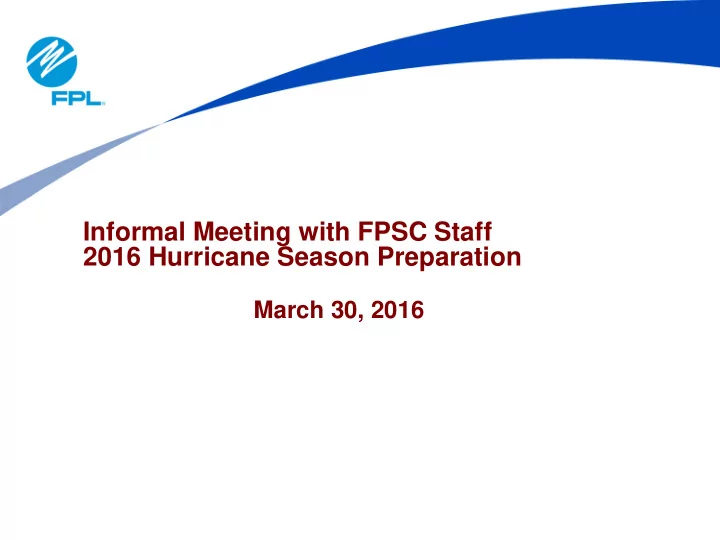

Informal Meeting with FPSC Staff 2016 Hurricane Season Preparation March 30, 2016
Preparations FPL’s Hurricane Preparedness Plan • Continue to strengthen the infrastructure Infrastructure • Prepare the storm organization Communication Organization • Refine the restoration plan Restoration • Communicate Communicate 2
Continue to Strengthen the Infrastructure Infrastructure Organization Communication Distribution Hardening Restoration • Complete CIF/Community Projects • Initiate “Wind Zone” and “Geographic” hardening • Initiate lateral hardening 3
Continue to Strengthen the Infrastructure Infrastructure Organization Communication Transmission Hardening Restoration • CPOC replacement and storm surge/flood initiatives complete • Continue to replace all wood structures 4
Continue to Strengthen the Infrastructure Infrastructure Organization Communication Distribution Pole Inspections Restoration • 1.2 million FPL poles • Inspect 150,000 poles annually • Complete follow-up work 5
Continue to Strengthen the Infrastructure Infrastructure Organization Communication Transmission Pole Inspections Restoration • 65,000 structures • Visually inspect 100% annually; complete climbing/bucket truck cycle inspections and follow-up work • Inspect key facilities (500kV/CIF) before storm season 6
Continue to Strengthen the Infrastructure Infrastructure Organization Communication Distribution Vegetation Management Restoration • Trim 15,000 miles annually Feeders (3-year average cycle) Laterals (6-year average cycle) Mid-cycle trimming • Trim CIF before storm season • Encourage “Right Tree - Right Place ” 7
Continue to Strengthen the Infrastructure Infrastructure Organization Communication Transmission Vegetation Management Restoration • Inspect / clear 100% of ROW annually 8
Prepare the Storm Organization Infrastructure Organization Communication Annual Preparations Restoration • Identify/staff storm roles • Train 4 regional staging site exercises Annual company-wide “dry run” event • Forensic teams ready 9
Refine the Restoration Plan Infrastructure Organization Communication Restoration • Safely restore in shortest time How we restore and prioritize restoration 10
How We Restore Power Guiding principle – Safely restore power to the largest number of customers as quickly as possible. • First – Repair damaged power plants, transmission lines and substations; • Simultaneously, restore power to CIF (e.g., hospitals, police/fire stations); • Also, restore service to the largest number of customers in the shortest amount of time , including key community needs (e.g., grocery stores, pharmacies, gas stations); and • Once larger/key repairs have been made, restore service to smaller groups /neighborhoods, converging on the hardest hit area(s), until all customers are restored . Insert system model graphic 11
Refine the Restoration Plan Infrastructure Organization Communication Restoration • Resource plans in place Logistics Mutual assistance/contract crews Increased inventory levels Increased use of new technologies for mobile damage assessment and situational awareness. 12
Enhance Communications Infrastructure Organization Communication Restoration • Annual FPL / County EOC meetings • Governmental & community communications 13
Assistance Provided to Other Utilities • None in 2015 14
Potential Issues with a 2016 Storm • Facilities impacted not yet storm-hardened Infrastructure • Multiple storms Organization Communication • Catastrophic storms Restoration • Resources unavailable 15
Hurricane Preparedness Plan Summary • Infrastructure strengthened Hardening; Pole inspections; Vegetation management Infrastructure • Organization prepared Organization Communication Trained / ready • Restoration plan tested & refined Restoration Lessons learned; Technology; Forensics • Communications improved/ready 16
Hardening and Storm Preparedness Progress / Plans FPL HARDENING AND STORM PREPAREDNESS PROGRESS/PLANS 2015 2014-2015 (1) DISTRIBUTION POLE INSPECTIONS 2016 Plan 1,160,848 (2) # poles on system beginning of period 1,163,099 1,168,532 # wood inspected 133,243 266,815 133,363 # non-wood inspected 18,436 31,189 11,887 Total # inspected - all pole types 151,679 298,004 145,250 # replaced 9,116 18,788 TBD (1) Current 8-year inspection cycle began 2014, (2) Current 8-year inspection cycle target TRANSMISSION POLE/STRUCTURE INSPECTIONS (SPI#3) 2015 2012-2015 2016 Plan Wood Poles/Structures 15,542 (3) # poles/structures on system beginning of period 11,550 9,662 # ground level visual inspections 100% 100% 100% # detailed climbing/bucket inspections 2,294 10,294 1/6 # replaced 1,888 16,665 TBD Concrete and Steel Poles/Structures # poles/structures on system beginning of period 53,005 49,667 55,697 # ground level visual inspections 100% 100% 100% (3) 2nd 6-year cycle began 2012 DISTRIBUTION SYSTEM HARDENING 2015 2006-2015 2016 Plan # CIF projects (EWL) 43 421 91 # Community Projects 16 126 17 # Geographic/Windzone Feeder Projects (4) 5 5 13 # '01' switches 16 270 16 Flood/Surge mitigation (# vaults) (5) 6 12 (4) Projects began 2015, (5) Downtown Miami Network vaults completed in 2015 TRANSMISSION HARDENING (SPI#4) 2015 2006-2015 2016 Plan # wood poles/structures on system beginning of period 11,550 26,147 9,662 # wood poles/structures replaced 1,888 16,665 1,400-1,800 Ceramic Post Insulators replaced (# structures) (6) 0 5,621 0 Flood/Surge Monitors (# substations) (6) 0 222 0 (6) Completed in 2015 Current VEGETATION MANAGEMENT (SPI #1) 2015 2016 Plan Cycle 13,554 (7) 13,554 (7) 13,417 (8) # system feeder miles to clear in current 3-yr cycle # feeder miles cleared 4,209 13,095 4,427 # mid-cycle feeder miles cleared 7,218 21,562 7,100 # system lateral miles to clear in current 6-yr cycle (9) 22,722 22,722 22,722 # lateral miles cleared 3,817 11,626 3,800 136,695 (10) Total # miles cleared 15,244 15,327 105,000 (11) # trees removed 20,000 TBD (7) Cycle completed 2015, (8) New cycle began 2016, (9) Cycle began 2013, (10) # since 2006, (11) # since 2010 Storm Preparedness initiative (SPI) 17
Recommend
More recommend